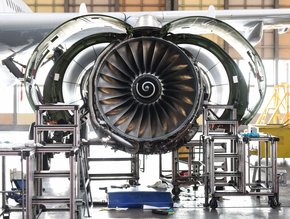Industry 4.0's outsized impact on the back office

The fourth industrial revolution will digitally transform manufacturing, but this time, white-collar staff could feel much of the impact—and reap potential new benefits.
Most of the buzz generated by digital manufacturing breakthroughs such as 3D printing, big data analytics and human-robot collaboration (HRC) focuses on the impact expected on the factory floor. While plant operations and workers will definitely experience disruptions due to Industry 4.0[1], this industrial revolution may actually have its most profound effects in the offices and bullpens of white-collar staff.
Industry 4.0 integrates digital connectivity with manufacturing technology to build products faster, better and cheaper. By 2030, the global value-added potential of this wave of innovation will reach 1.4 trillion US dollars, based on research conducted by Oliver Wyman that covers a variety of manufacturing industries.[2] By providing real-time information about customer demand, production capacity, operational performance and product quality, Industry 4.0 will enable decision making that dramatically improves process efficiency in everything from pricing to production planning. Consequently, while the factory floor will undoubtedly benefit enormously from Industry 4.0, the greatest gains could actually occur in non-production areas. And as Industry 4.0 digital innovations such as algorithm-based decision-making take hold in areas such as R&D, product launches, pricing, planning, dispatching and purchasing, companies will likely automate many jobs currently done by humans. At the same time, however, new digitally supported opportunities will emerge for white-collar employees that possess the required skills and capabilities.
A cross-functional efficiency revolution
The changes will be both broad and deep, with more of the tedious and tough duties taken over by office automation and artificial intelligence capabilities. The following examples illustrate some of the changes ahead for non-manufacturing functions.
- Demand forecasting and intelligent pricing: Leaders rely on demand forecasts to make important business decisions in everything from sales and production planning to pricing. Today, these forecasts result from estimates made by sales and marketing executives, market expectations, and overall market competition. Imperfect and unresponsive to developments beyond the sales and marketing departments knowledge base, such forecasts typically lack rigor. Instead, some companies have begun to improve on this approach by adding big data techniques. Automatically drawing on data from a wide range of sources, centralized analytic algorithms predict future demand from different customer segments and geographies. Ultimately, real-time, algorithm-based demand forecasting will feed into many related processes, such as market research, sales planning, production planning and scheduling with very little human assistance.
- Smart purchasing and outsourcing: Benefits will result from increased integration transparency with suppliers, access to a wider range of suppliers and greater flexibility in make-or-buy decisions. Manufacturers will standardize the exchange of fully digitized product- and production-related data with suppliers. Doing so will enable them to overcome a variety of current shortcomings such as inconsistent digitization, which can hamper the request-for-proposal process.
- R&D efficiency and product launch: Gains will emerge from extensive simulation, data integration, big data pattern recognition and real-time feedback loops. Digital innovations will make R&D more efficient, for example, through the structured analysis of operating data and concurrent mechatronic engineering between manufacturers and suppliers using digital models. As simulations improve, R&D departments will require fewer costly, labor-intensive physical prototypes, replacing them with digital modeling and virtual testing environments.
New challenges, but new opportunities, too
In each of the above examples, Industry 4.0 will drive new levels of efficiency across a manufacturer’s white-collar functions, enabling companies to do much more, often with fewer back office employees. At the same time, however, these digital solutions will generate new business opportunities by, for example, enabling manufacturers to help their business-to-business (B2B) customers reduce costs, improve their own customer offerings and create both value and jobs. Several examples of this phenomenon have already emerged:
- A leading tier-1 automotive supplier that has focused strongly on Industry 4.0 technologies is tendering its expertise in this area to other manufacturers. The company is offering connectivity solution software and hardware for industrial manufacturing. The primary thrust of the business involves providing greater productivity and improved energy efficiency.[3]
- A railcar OEM offers a cloud-based software suite that improves asset management and operating efficiency for rail operators. Customers benefit from reduced maintenance and energy costs as well as reduced track usage. By increasing asset utilization, rail operators can reduce their capital expenditures over the long run.
- A maker of paper manufacturing machinery offers customers software that optimizes input consumption and increases paper production yields. The solution collects and analyses data, makes real-timer estimates of the optimization potential of a process, and automatically adjust process parameters. The OEM charges a monthly fixed fee for installation and can receive success-based revenue streams if the customer achieves agreed-upon savings on production costs. Additionally, the company has the option to build a production consulting business using insights from the data and algorithms.
- Aircraft component suppliers and OEMs can create new sources of recurring revenue by offering innovative data-driven maintenance, repair and overhaul (MRO) solutions to airline customers. Today, a large aircraft generates over 500 gigabytes of data from 600,000 parameters per flight. Advances in MRO will come from better analysis of this data for predictive maintenance activities. By tracking aircraft health parameters in real-time during operation, companies can formulate efficient MRO plans before equipment reaches critical operating thresholds.
Profiling tomorrow’s white-collar worker
Disruptive yes, but these changes can also create opportunities for the firms and white-collar workers that embrace them. Doing so will require flexibility and a willingness to gain digital savvy, compelling employees to learn different ways of working and to take on new responsibilities. While clerical and administrative white-collar positions are vulnerable to Industry 4.0 disruptions, with the right training and experience, people in those jobs can begin to transition to roles that rely on human problem-solving capabilities and creativity—human talents that algorithms can’t as yet match. Professional staff such as engineers, accountants, lawyers and scientists could also face competition from disruptions like virtual simulations, automated cost controls and advanced decision-making algorithms. But here again, while office automation handles the rote elements of these jobs, companies will aggressively exploit their evolving digital capabilities to create new business models and revenue streams—opportunities that will require skilled human participation to succeed. The connected nature of Industry 4.0 will also allow people with sought-after skills to serve companies on a global basis without leaving home or to participate in crowd-sourcing initiatives, thus significantly expanding their marketability.
As the above suggests, tomorrow’s white-collar worker will require a different set of skills to succeed. Just as blue-collar workers of the future will need better training and education, focusing particularly on rudimentary science, technology, engineering and mathematics (STEM) disciplines, white-collar workers will also need their own refresher courses. In addition to STEM training, other disciplines include a focus on big data analytics, cybernetics, and data mining and management. Companies themselves will likely focus on innovations like crowdsourcing and create vetted global networks of experts to resolve on their toughest problems. At the same time, the massively expanded attack surfaces created by Industry 4.0 networks mean companies will have to approach digital security from a much more integrated perspective, with business staff taking responsibility for safeguarding data rather than depending solely on the security team.
Industry 4.0 promises to reinvigorate manufacturing, but as with every other industrial revolution, it will also displace workers that lack the skills and training needed to operate in the new environment. There is a bright side, however: the forces behind Industry 4.0 will also open new opportunities for white-collar workers who can adapt to their new connected environment.
Michelle Hill is Vice President, Automotive, at Oliver Wyman






